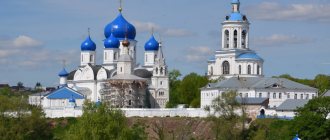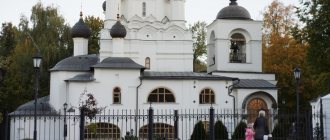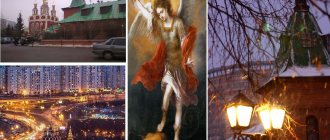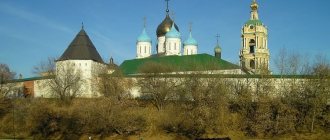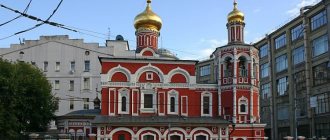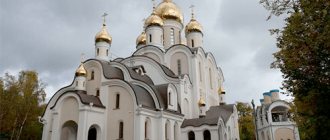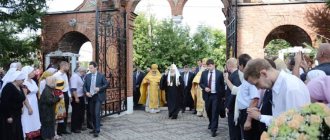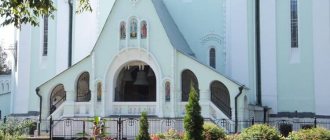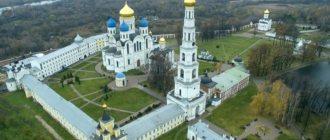Church of the Intercession of the Blessed Virgin Mary in Fili
The Church of the Intercession of the Blessed Virgin Mary in Fili is one of the most beautiful in Moscow. This tall, five-tiered church is visible from afar; it can be seen from almost anywhere in Filevsky Park. Despite the abundance of architectural decorations characteristic of the Baroque style in which this temple was built, it looks elegant and even airy - especially in the summer, when it is surrounded by lush greenery.
Originally from Time of Troubles: the history of the Church of the Intercession of the Virgin Mary in Fili
Initially, there was a small wooden church in this place. In 1619, after the end of the Time of Troubles and the election of Mikhail Romanov as Tsar, several churches of the Intercession of the Most Holy Theotokos were erected in the country: thus, the new monarch decided to perpetuate the victories of the Russian troops over the Poles who tried to take Moscow in the fall of 1618, on the Feast of the Intercession. One of these churches was built in Fili, and it stood there until 1690, when a large stone temple began to be built there to replace it.
Salvation Prayer
This construction was preceded by the dramatic events of 1682 - the struggle for power between the Miloslavsky and Naryshkin families, which ended with the Streletsky revolt. After the Miloslavskys, led by Princess Sophia, spread a rumor in the capital that Natalya Naryshkina’s brothers had killed Tsar Fyodor Alekseevich, the archers burst into the part of the Kremlin palace where the Naryshkins lived, intending to deal with all members of this family.
Natalya’s two brothers were killed, and she helped the third, the youngest Lev Naryshkin, who was then only fourteen years old, to hide in the women’s quarters. The frightened teenager ran into one of the rooms and saw an icon of the Savior Not Made by Hands hanging on the wall. He began to fervently pray for salvation and made a vow to build a large stone temple near Moscow if he survived.
Lev Kirillovich Naryshkin
The Sagittarius did not find young Lev Naryshkin that day - he escaped and lived safely until 1689, when his nephew Peter removed Princess Sophia from the throne and became the ruler of Russia. Soon after this, the young king made him the head of the Ambassadorial Prikaz and gave him the village of Fili, in which Naryshkin began to fulfill his vow.
Two churches under one roof
In 1690, construction began on the stone church, and four years later the first service took place there. A large stone building united two churches: the Intercession of the Blessed Virgin Mary on the first floor and the Savior Not Made by Hands - in memory of the salvation of Lev Naryshkin - on the second.
The temple was erected at the expense of Naryshkin and was located on the territory of his estate, that is, formally it was a house temple, but entry was open to everyone. Peter the Great himself often visited this church. In 1705, he even donated a large sum - four hundred gold chervonets - to decorate it with stained glass windows.
Useful materials
Soon after the construction of the temple, the village of Fili was renamed Pokrovskoye. Every year more and more pilgrims came there from different cities of Russia - many of them then went to the Savvino-Storozhevsky Monastery, located in Zvenigorod, and as a result, a wide road was built between this city and Pokrovsky, which later turned into a highway.
Survivor of two wars
During the Patriotic War of 1812, the Church of the Intercession was almost destroyed by soldiers of the Napoleonic army. Having captured the village, they set up a stable on the first floor of the temple, and on the second - a workshop in which they sewed boots and horse harnesses and repaired clothes. The interior of the temple was badly damaged, and after the war it had to be refinished.
For the second time, the Church of the Intercession was on the verge of destruction in the twentieth century. They wanted to close it after the coup of 1917, but the priests and parishioners managed to do something almost impossible at that time - to ensure that the temple continued to operate. Subsequently, the church several times tried to be closed by the management of the factory built nearby: at first they wanted to demolish it in order to build a store in its place, later there were projects to preserve its building, but set up a club for factory workers in it.
But the parishioners, who became more and more numerous every year after the closure of other churches in this area, fought off all these “attacks,” and the Moscow authorities did not dare to close the church, which had such a large community.
However, at the beginning of the Great Patriotic War, the Filevsky temple still had to be closed and even deprived of its bright gilded domes, otherwise it would have become too good a landmark for enemy bombers.
On July 12, 1941, the last service was held in it, after which the domes were removed from it and its upper tier was dismantled.
From 1943 until the end of the war, a military hospital operated on the ground floor of the temple. The building was hit by incendiary bombs several times, and although they were quickly extinguished, after the war it remained badly damaged and required serious restoration.
Neighborhood to the museum
In 1955, the Church of the Intercession began to be restored, but progress was very slow. After the first floor was repaired, a paper warehouse was set up there, and although the restoration of the upper tiers continued, in those years one could only dream of the temple becoming operational again. And pray.
In 1971, the not yet fully restored building of the Intercession Church was transferred to the Museum of Ancient Russian Culture and Art named after Andrei Rublev. Nine years later, a branch of the museum opened there, and by the mid-80s, the restoration of the upper floors was completed. And around the same time, Orthodox residents of this area of Moscow began to make their first attempts to achieve the resumption of services in the temple.
And they again managed to do the almost impossible - to obtain permission to create a parish in this church in 1990, even before the collapse of the Soviet Union. And two years later, in the Church of the Intercession of the Most Holy Theotokos, prayers began to sound again and the church choir began to sing. For several years after this, services were held there only on major church holidays, but then they became regular. At the same time, a branch of the museum continued to operate in the building, and only recently, in 2019, the Intercession Church was completely transferred to the Russian Orthodox Church.
Architectural style: Baroque in the Russian style
The style in which Lev Naryshkin built the Church of the Intercession bears his name - Naryshkin Baroque. Peter I's uncle, like his famous nephew, was a great lover of everything European, and he liked lavishly decorated baroque buildings, but at the same time he did not want to completely abandon Russian traditions. As a result, the entire Naryshkin estate in Fili, including the temple, was built in a unique style: the buildings were richly decorated, but did not seem bulky.
The composition of this church is also traditional for Russian Orthodox churches - its first floor has a rectangular shape, and the second and subsequent floors have an octagon shape. Buildings of this type are called “octagon on quadrangle”, and initially wooden churches were built this way, and after the construction of the temple in Fili, other stone churches of this shape began to appear.
It is not known exactly who the architect of the Intercession Church was. In 1712, there was a fire at the Naryshkin estate, during which many documents burned, including all the papers related to the construction of the church, which mentioned the name of its creator. Some researchers suggest that the architect of the temple was Yakov Bukhvostov, who created other buildings in the Naryshkin Baroque style, but there is another version - that it was built by another famous architect of that time, Pyotr Potapov.
A box for a humble king
The interiors of this temple were created by the famous icon painter and woodcarver Karp Zolotarev. Unfortunately, the interior decoration of the lower church has not survived to this day - everything was destroyed by the French in 1812. But on the second floor, almost all works of art created by Zolotarev survived. There are unique carved Royal Doors, a gilded altar and a nine-tiered iconostasis, which have not only religious, but also museum and historical value.
Since the temple was built on the estate of a close relative of Peter I, it was obvious that the tsar would certainly visit this place from time to time. Therefore, on the second floor of the church, a “royal box” was made - a small balcony where the Russian ruler could be during services. However, Peter Alekseevich, coming to the Church of the Intercession, preferred to stand modestly among the other worshipers and never used this balcony.
Temple Shrines and Celebrations
The main shrine of the church in Fili is an impressive carved iconostasis. In addition to many holy faces, you can see on it the original image of the Intercession of the Blessed Virgin Mary, as well as the icon of the Three Joys.
The original of the Savior Not Made by Hands was lost, but the cathedral contains a copy of it, which remains no less revered to this day.
The newly opened parish holds daily services and celebrates patronal feasts:
- October 14 – Protection of the Mother of God;
- August 29 – in the name of the Savior Not Made by Hands.
Schedule of prayers:
- weekdays – 8:30 and 17:00;
- Sunday – 7:30 and 10:00.
The main shrine of the church in Fili is the carved iconostasis
Interior of the church in Fili
The temple interior is the work of Karp Zolotarev
The work of great icon painters
Iconostasis: The Savior Not Made by Hands and the Kazan Icon of the Mother of God
The main shrine of the Church of the Intercession was the icon of the Savior Not Made by Hands - the same one in front of which Lev Naryshkin prayed for salvation during the Streletsky riot and which he then transported to Fili from Moscow. It was also destroyed during the Patriotic War of 1812, but a copy of it was preserved, which can be seen in the temple even now.
Apostles Peter and Paul. Karl Zolotarev.
Some of the icons of the upper church were painted by Karl Zolotarev - among them, “Apostle Peter and Apostle Paul”, “John the Baptist and Alexei the Man of God” and “The Dormition of the Mother of God” especially stand out. The temple also contains icons of another great master of the 17th century, Tikhon Filatyev, which art historians unanimously consider masterpieces of the early Peter the Great’s time.
Two churches - two patronal days
Since the lower church in Fili is consecrated in honor of the Intercession of the Most Holy Theotokos, and the upper one in honor of the Savior Not Made by Hands, there are two patronal feasts in this church. They are always celebrated very solemnly. The Russian Orthodox Church celebrates the Day of the Savior Not Made by Hands on August 29, and the Day of the Intercession of the Most Holy Theotokos on October 14. Even in those years when the top floor of the Filevsky temple was occupied by a museum, on these days, as well as on Easter, festive services were held in it and it was opened to believers.
Now other services are held on the second floor, but the Day of the Savior Not Made by Hands still remains the main holiday of the upper church. And still, as in past centuries, every year there is a prayer in honor of the Icon of Christ the Savior Not Made by Hands:
“We worship Your Most Pure Image, O Good Christ, asking for forgiveness of our sins, O Lord God: for by the will of Thou didst thou deign to ascend in the flesh to the cross, that thou mightest deliver what Thou hast created from the work of the enemy. Thus we cry out to You in gratitude: You have filled all our Savior with joy, having come to save the world.”
Church in Fili - a light lace fairy tale
The temple in the Naryshkin estate is a house church intended for the owners of the estate and their guests. The rich external decoration with white stone lace, enchanting elegance, tiered structure is evidence of the noble origin of the owner and his virtue.
Church structure
The Church of the Intercession in Fili has two altars: the lower tier is a winter heated church in honor of the Intercession of the Virgin Mary, in the upper tier is the main church in honor of the Savior Not Made by Hands. Contrary to canonical tradition, the altars are located vertically above each other; the lower altar does not protrude to the east, as was customary.
The five-tiered church looks like a skyward pyramid. The tiers are separated from each other by patterned belts. Through the large windows of each tier a stream of light pours into the building.
4 side chapters attached to the main body of the temple , oriented to the cardinal points. The central head stands far away and rises upward. The eastern and western chapters are crowned with double-headed eagles under crosses, and the central chapter is also crowned.
On both sides the church embraces an open walkway, where wide, spreading staircases lead. The bell tower and the church are combined, the ringing tier is located above the temple: the bells hang in the spans of the middle tier. Inside the walls there is a staircase leading to the bell tower.
Exterior decoration
The stone church built by Lev Kirillovich turned out to be new in form in comparison with ordinary churches. The corners of the building are decorated with columns supporting cornices, above which elegant carved scallops are installed.
The author of the carved decoration, Karl Ivanovich Zolotarev , master of the Armory, introduced white stone details into the architecture of the temple: spiers, scalloped tops of windows and doors.
White stone window frames of unequal shape, with thin columns, are complemented by openwork crosses that shine with the gold of faceted cupolas, their elegance increases vertically.
The Church of the Intercession of the Blessed Virgin Mary is magnificently decorated with carved white stone. Exquisite white lace looks elegant against the background of red walls, creating a festive feeling. Even on cloudy days, the airy, intricate, slender church in Fili looks solemn and joyful.
“Everything here is easily built and at the same time set in motion, reminiscent of a light lace fairy tale, pure Moscow beauty,” is how the architects characterize the Naryshkin baroque.
Interior
In the interior of the Church of the Intercession of the Most Holy Theotokos, the theme of royal greatness sounds: the internal structure testifies to the heavenly: “The Church is the earthly heaven!”
In the center of the iconostasis is the temple icon of the Savior Not Made by Hands , in front of which young Naryshkin prayed for salvation. The boyar honored the image: the icon was covered with a golden robe, decorated with emeralds, diamonds and rubies.
The church is small, inside there is a separate box, nicknamed “royal”: a narrow two-tier balcony in front of the iconostasis, where the owner of the estate and his crowned nephew were supposed to stand during the service. By the way, while visiting the temple in Fili, Peter I never went up to the royal box. The Tsar remained during the service on the choir along with the singers and sang with them.
In the Church of the Intercession of the Blessed Virgin Mary in Fili there is no wall painting; it was replaced by a 9-tier iconostasis, decorated with wooden carvings and topped with a crucifix. The Savior and the Mother of God are depicted in royal vestments.
Above the carved crucifix is an image of the Life-Giving Trinity surrounded by angelic forces. The carving of the iconostasis, sparkling with gold, is a symbol of the Garden of Eden, lush and beautiful. The main symbol of Christ, his suffering and Holy Communion is a grapevine, which is surrounded by symbols of heavenly abundance: flowers, berries and shells with pearls, carved baskets.
To the left of the royal doors is the image of the Dormition of the Mother of God. The lower tier of the iconostasis is dedicated to the house of the Romanovs and Naryshkins - icons associated with the owners of the house and their august relatives:
- The image “Apostles Peter and Paul” is dedicated to the name day of Peter I.
- John the Baptist and Alexy, Man of God” is dedicated to the name day of the owner’s brother Ivan Naryshkin, killed by archers, and Tsar Alexei Mikhailovich.
- Icon of the martyrs Adrian and Natalia in honor of Tsarina Natalia Kirillovna.
- Images of Saint Leo, Bishop of Katansky and Great Martyr Paraskeva, dedicated to Lev Naryshkin and his wife Praskovya.
How does the parish live today?
The Orthodox community of the Church of the Intercession actively supports a variety of people in need of help:
- elderly;
- lonely;
- find themselves in a difficult life situation;
- the poor.
In addition, the church operates a Sunday school and an anti-sectarian service, as well as the Filevtsy Orthodox youth movement, whose members participate in various volunteer projects and organize sporting events for parishioners.
Art ministers
Iconostasis of the upper chapel of the temple
The rector of the Church of the Intercession is Hieromonk Alexander (Zarubin). Immediately after his appointment to this position, he began negotiations with the Federal Agency for State Property Management, seeking the complete transfer of the temple to the Orthodox Church, and, in the end, succeeded in this.
The management of the Andrei Rublev Museum tried to prevent this, appealing to the fact that without the supervision of art historians, all the unique icons and the Royal Doors, located in the upper church and having enormous historical and artistic value, would be spoiled, but the rector managed to convince the Federal Property Management Agency that the clergy also know very well how to handle fragile ancient objects.
“This monument is not just formally of federal significance. This is a de facto gem. “I understand all the responsibility that falls on the parish and on me when such a monument is transferred to the use of the Russian Orthodox Church,” said Hieromonk Alexander in an interview when the issue of transferring the temple was being decided.
And now the rector and other priests serving in the Church of the Intercession are fulfilling this promise, carefully ensuring that the interior of the church is not damaged by temperature changes or low-quality smoky candles. Some of them, for example, Archpriest Boris Mikhailov and Deacon Georgy Malkov, are art historians by first, secular education, so the historical values of the Church of the Intercession are in good hands.
Activities of the parish
The Filevsky parish has always been numerous and at present there are quite a lot of parishioners who actively participate in the life of their church, which operates:
- Sunday School;
- pilgrimage center;
- Church History Museum;
- youth movement "Filevtsy".
Parishioners actively participate in social activities, helping those who need it.
Road to the temple
The address of the Church of the Intercession of the Blessed Virgin Mary is Moscow, Novozavodskaya street, building 6 . The nearest metro station is “Fili”, from there you can walk to the temple or take almost any public transport 500 meters along Novozavodskaya Street.
The building of the Filevo church has not yet been fully restored, but even despite this, it remains one of the most beautiful Orthodox churches in Russia. A temple that can be seen from afar and feel an irresistible desire to go inside.
